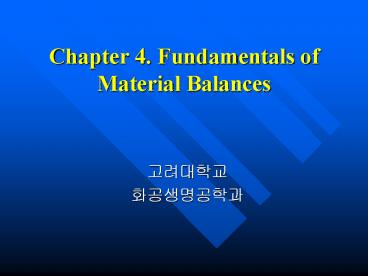Chapter 4. Fundamentals of Material Balances - PowerPoint PPT Presentation
1 / 13
Title:
Chapter 4. Fundamentals of Material Balances
Description:
The catalytic dehydrogenation of propane is carried out in a continuous packed bed reactor. ... pounds per hour of pure propane are fed to preheater where they ... – PowerPoint PPT presentation
Number of Views:1467
Avg rating:3.0/5.0
Title: Chapter 4. Fundamentals of Material Balances
1
Chapter 4. Fundamentals of Material Balances
- ?????
- ???????
2
Introduction
- Material Balance (Mass Balance)
- Based on the law of conservation of the mass
- (total mass input) (total mass output)
- Objectives of this chapter
- Drawing process diagrams
- Writing material balance equations
- Understanding process variables
- Solving equations with unknown variables
3
4.1 Process Classification
- Classification of processes
- Batch feed is charged, products are removed
some time later - Continuous inputs and outputs flow continuously
- Semibatch process mixed process
- Steady state (????) process variables do not
change with time - Transient (unsteady) state (????) process
variables change with time small scale
productions
4
Balances
- The general balance equations
- (Input) (Generation)
- (Output) (Consumption) (Accumulation)
- Balance (or Inventory)
- Two types of balances
- Differential balance per time
- Integral balance during a certain period of time
5
Example
Process diagram
Problem
100 kg /hr of a mixture of benzene (B) and
toluene(T) that contains 50 benzene by mass are
separated by distillation into two fractions. The
mass flow rate of benzene in the top stream is
450 kg B/hr and that of toluene in the bottom
stream is 475 kg T/hr. The operation is at steady
state. Write balances on benzene and toluene to
calculate unknown component flow rate in the
output streams.
45-0 kg B/hr q1 kg T/hr
500 kg B/hr 500 kg T/hr
q2 kg B/hr 475 kg T/hr
Material Balance
Benzene balance 500 450 q1 Toluene
Balance 500 q2 475
Solution Q1 50 kg T/hr Q2 50 kg B/hr
6
Integral balances on batch or semi-batch processes
- Integral balance on batch processes
- Sometimes it can be treated like steady-state
processes - Integral balance on Semi-batch and continuous
process - Sometime it can be easily solved.
- Require integration over period of time
7
4.3 Material Balance Calculations
- Objective
- Given values of input, output ? calculate unknown
values - Flow Charts simple way to visualize process
flow - PFD (Process flow diagram)
- PID (Process and Instrument diagram),
8
Benefits of using flowcharts
Flowchart
Process Description
The catalytic dehydrogenation of propane is
carried out in a continuous packed bed reactor.
One thousand pounds per hour of pure propane are
fed to preheater where they are heated to a
temperature of 670 C before they pass into the
reactor.The reactor effluent gas, which includes
propane, propylene, methane and hydrogen, is
cooled from 800 C to 100 C and fed to an
absorption tower where the propane and propylene
are dissolved in oil. The oil then goes to a
stripping tower in which it is heated, releasing
the dissolved gases these gases are recompressed
and sent to a high pressure distillation column
in which the propane and propylene are separated.
The product stream from the distillation column
contains 98 propane. The stripped oil is
recycled to the absorption tower.
Preheater
Reactor (dehygdro -genation)
Cooler
100 lbm/h propane
600 C
800 C Propane Propylene Methane Hydrogen
Recycle Stream (Propane)
110 C
Absorption Tower
Stripping Tower
High P Distillation
Methane Hydrogen
Oil
Oil
Propylene
Complex, not easy to understand
Compact, easy to understand
9
Drawing a flowchart
- Write the values and units of all known stream
variables at the location of the streams on the
chart. - Assign algebraic symbols to unknown stream
variables. - Write variable names and units on the chart.
400 mol/h
0.21 mol O2 /mol 0.79 mol N2 /mol T320 oC, P
1.4 atm
400 mol/h
x mol O2 /mol (1-x) mol N2 /mol T320 oC, P 1.4
atm
10
Material Balances
- Flowchart scaling up/down
- Changing values of all amounts or flow rates by
proportional amount. - Compositions remain unchanged.
- Basis of calculation
- If flow rates are given, use specified values and
units. - If flow rates are not given, assume one of input
flow rates.
11
Problem Bookkeeping
- A procedure to discover that all the required
information is available to solve specified
problem. - Procedure
- Drawing flowchart
- Identifying variables
- Identifying equations
- Degree of freedom analysis
12
Available Relations
- Material balances
- No. of species (N) No. of equations
- An energy balance
- One unknown ( T, Q, or m)
- Process specification
- Requirement (based on economics,)
- Physical properties and laws
- Thermodynamic relations and physical properties
data - Physical constraints
- X1 1 then X2 1-X1,
13
Outline of a Procedure for Material Balance
Calculations
- Draw a flow chart, and fill in all given values.
- Choose as a basis of calculation an amount or
flow rate of one of the process streams. - Label unknown stream variables on the chart.
- Do the problem bookkeeping.
- Convert volume flow rates to mass or molar flow
rates. - Convert mixed mass and molar flow rates to mass
or molar flow rates. - Translate given information to equations.
- Write material balance equations.
- Solve equations.
- Scale up/down.































